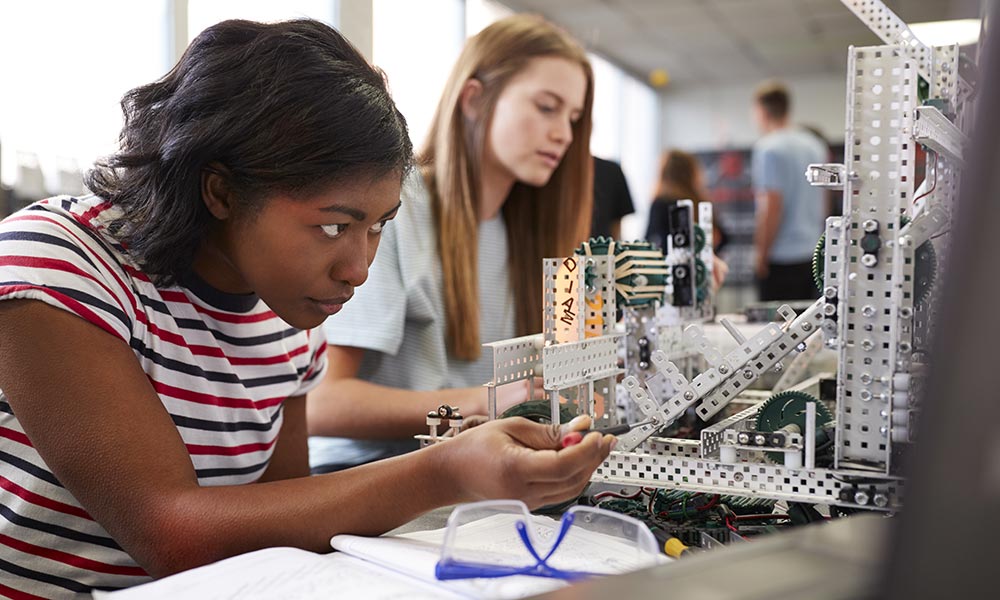
HOW STEM EDUCATION CAN CLOSE GENDER, ETHNICITY, AND INCOME GAPS
STEM education is vital to preparing students to face the global challenges of the future. A key to expanding U.S. competitiveness is to encourage scientific and technical education among girls and students of color.
The United States relies on continued scientific and technological advancement for our economy to survive and thrive, including innovation in products and processes. Our societal development depends a great deal on knowledge in STEM: science, technology, engineering, and mathematics. Proficiency in these areas is vital to our students, who will grow into leaders and innovators who must take on the economic, health, and security challenges older generations leave behind. However, the United States falls short in in these fields compared to other industrialized countries, threatening to diminish our global competitiveness.
To face the increasing challenges that climate change, security threats, technology changes, and global health issues will bring, the U.S. needs to continue to emphasize STEM, which can also be a force for promoting equity, diversity, and inclusion. Encouraging more girls and students of color to take an interest in the STEM fields can address various inequities and develop a larger pool of professionals who can take on tomorrow’s problems.
Importance of STEM Education
In today’s dynamic world, preparing our youth to solve problems, interpret information, and make evidence-based decisions is more important than ever. Our future leaders need to have enough skills and knowledge to meet evolving technological demands, address workforce changes, and counteract global safety and security threats. Current competency criteria are no longer sufficient; STEM education needs to prepare students to develop aptitudes that surpass today’s standards.
Closing the Gaps through STEM Education
More importantly, gender, geographic region, ethnicity, and socioeconomic status should not determine STEM proficiency. The STEM fields have the potential to break down cultural disparities and close opportunity gaps that often exist in science and math. Schools can encourage more girls and students of color to become more interested in STEM disciplines.Encouraging more STEM education for girls is essential, considering how women comprise half of the college-educated workforce in the U.S. However, this proportion does not reflect the number of women, especially women of color in STEM-related fields. It can be challenging for ethnic minorities and girls to develop an interest in these occupations when they don’t see many scientists and engineers who look like them. Furthermore, when work teams consist of diverse members, they tend to generate more creative solutions, which is another notable reason to continually open the field to diverse students.
STEM in After-school Programs
Schools can encourage more marginalized students to engage in STEM by helping them envision solving technical problems to make pro-social impacts, such as reducing hunger, eradicating illness among at-risk populations, or creating jobs that benefit marginalized communities. In addition to the traditional curriculum, schools can encourage more girls and minority students by setting up after-school programs. Such initiatives provide experiential learning environments that expose students to STEM subjects and thus pave the way to higher education and career paths in these disciplines.
Encouraging girls was the idea behind the collaboration among the Intel Foundation, the Gordon and Betty Moore Foundation, the STEM Next Opportunity Fund, and the Charles Stewart Mott Foundation. These groups initiated the Million Girls Shootout, which encourages a million girls to participate in STEM education over the next five years. After-school programs across the country have received funding from this collaboration to create after-school programs to achieve the Million Girls Shootout's objectives.
During the COVID-19 crisis, many schools have ensured that their students still have access to critical STEM-related opportunities through distance learning. At the same time, students can learn from the pandemic and discover how technology and science play a role in protecting public health and mitigating the effects of a global health emergency. The U.S. will need more diverse students to apply the scientific method and possess the skills to tackle future problems.
Article written by Sloane L, published by Admin